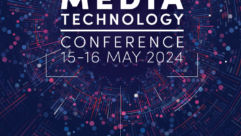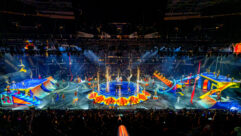ETIA 2014 Overview
Showcasing the state of the art in technologies for providing entertainment over digital infrastructures, the second Entertainment in the Internet Age (ETIA) conference was jointly sponsored by SMPTE and Stanford’s Center for Image Systems Engineering (SCIEN). On June 17 and 18, attendees gathered in the Nvidia Auditorium in the Huang Engineering Building on the Stanford campus to hear presentations from more than 50 industry experts. These visionaries shared their insights on best practices and future challenges for serving the entertainment needs of consumers worldwide over IP-based infrastructure — most commonly using the Internet.
Keynote Session: Web Business Models for Entertainment
In her keynote address, Vubiquity’s Darcy Antonellis provided impressive statistics about the state of nontraditional TV viewing. Only 21 percent of pay TV customers are making use of on-the-go viewing, but that number is increasing quickly. She stressed both the amount of behind-the-scenes work required to make the system work, and the need for improvement in the way options are presented to the viewer. Antonellis pointed out that users want a combination of a linear viewing experience with a personalized navigational capability and a social component for sharing, commenting, and rating. From a business perspective, Antonellis noted that the challenge is figuring out how to use big data to determine when to hit users with offers for something they want to buy at that time.
Photo Link:
www.wallstcom.com/SMPTE/SMPTE-DarcyKeynote.jpg
Photo Caption:
Darcy Antonellis Keynote Address
Tools of the Trade: VP9 and Cloud-Based Content Delivery
With participation by Jan Skoglund and Renganathan Ramamoorthy from Google, this panel focused on the motivation for the new VP9 codec that is now being deployed to enable 4K video streaming. VP9 has also greatly reduced buffering for YouTube viewers — by 25 percent in developed markets and 50 percent in developing markets — while allowing HD videos to start 15 percent faster. YouTube’s own Anil Kokaram followed up with some of the underlying technical data about the site’s streaming backend. He said that parallel processing is critical to timely content delivery, but that doing it effectively requires content-aware splitting of videos to avoid creating artifacts. He also said that YouTube typically does a relatively quick first pass on content to make it available as soon as possible, but then the company does a more time-intensive second “high-quality” pass for content that proves to be popular. Kokaram’s YouTube colleague Doug Stallard explained that the two-pass system enables the company to handle the 100 hours of user-generated content uploaded to YouTube every minute. Finally, Microsoft’s Martin Wahl took the audience through the advantages of a cloud-based media platform such as Microsoft’s own Azure Media Services. Microsoft’s Origin Server can provide real-time delivery of content in whatever format is needed for a particular viewing device, customized with business logic supplied by the content provider.
Photo Link:
www.wallstcom.com/SMPTE/SMPTE-ToolsoftheTradeSession.JPG
Photo Caption:
Renganathan Ramamoorthy, Google Chrome (Left), and Jan Skoglund, Google (Right)
Disruptive Innovation in Moviemaking, Sports, and Games
New York University’s Chris Bregler moderated a panel featuring Marv White of ESPN, Kim Libreri of Lucasfilm, and Erik Johnson of game-maker Valve. White marveled that the equipment ESPN needed to implement the famous “first and 10” first down overlay for football originally filled an entire truck but can now fit on a tabletop. Going forward, ESPN is working on new ways to mix broadcast and computer content; one example is to integrate video games with broadcast content.
Libreri revealed that Lucasfilm is exploring integrating movie technology into real-time games, such as in the company’s 1313 project. Interestingly, Lucasfilm has found that the same technology can be used as a creative tool for moviemakers, allowing directors to preview the end results of action on their motion-capture stages with full lighting, computer-generated costumes, and backgrounds.
Johnson from Valve represented the hard-core gaming community, which has more than 75 million active gamers as users. Valve’s core online gaming offering has been rounded out with a growing live tournament presence — now filling entire arenas — and even a documentary movie about the experience of creating the tournaments.
Exploration Zone: Toward the Entertainment Holodeck
Unique to this year’s ETIA conference was a demonstration of cutting-edge products and prototypes for virtual reality (VR), which was designed to showcase the variety of technologies needed to create the ultimate immersive entertainment experience. The event was dubbed “The Entertainment Holodeck” after the famous “Star Trek” virtual reality environment. Organizer David Singhal of LightField Interactive was able to attract a range of companies large and small, including many that were exhibiting their cutting-edge technologies publicly for the first time.
During the two-hour interactive session, attendees enjoyed hands-on demos of several recently introduced and much-talked-about products including Google Glass; a cinematic VR system from Jaunt VR; the Leap Motion Controller from Leap Motion; an untethered VR device from GameFace Labs; 3D technology from Sixense; a concave HIVE (Highly Immersive Visualization Environment) video wall measuring 10 feet by 24 feet; and Epson’s new augmented reality platform. Contributions from colleges and universities included a smartphone-based 3D modeling solution created by Stanford Project Tango and a wireless VR solution from the VR Club at Homestead High School in Cupertino, California. (A complete list is online at
. Click on the “Exploration Zone” link in the right-hand column.)
VR headsets were standard equipment among the exhibits, which included several immersive experiences built around Oculus Rift models augmented with audio. One of the most elaborate of these was “Surround House 2: Monsters in the Orchestra” from AMD. Shown for the first time in a personalized form, the system combines an Oculus Rift headset with high-quality headphones and a Leap Motion Controller to allow the user not just to fly around a 3D world, but also to control a variety of animated monsters and their simulated musical instruments. The immersive visual experience is coupled with a very effective 3D sound capability so that as the player and the monsters move, the sound from their instruments appears to move as well.
Photo Link:
www.wallstcom.com/SMPTE/SMPTE-ExplorationZone.jpg
Photo Caption:
Oculus Rift Demonstration With Dulce Ponceleon, IBM
Photo Credit:
Steve Phipps
Evening Event: Entertainment for the Next Generation
The most talked-about event at ETIA was a special evening session following the Exploration Zone demos. The session began with Electronic Arts co-founder and KPCB partner Bing Gordon in a one-on-one conversation with Dave Singhal, in which they discussed the power of immersive technologies to complement and enhance entertainment experiences. That discussion was followed by a panel in which Gordon and Singhal were joined by Kati London of Microsoft Research, Paul Debevec of the University of Southern California’s Institute for Creative Technologies, and David Cohen of Variety magazine, as well as moderator Jon Peddie of Peddie Research. The panel further examined the role of technology and the importance of content development platforms in bringing once-fanciful concepts for immersive experiences closer and closer to reality. The panel discussion also offered news on the most recent developments in the field.
Photo Link:
www.wallstcom.com/SMPTE/SMPTE-EveningEvent.jpg
Photo Caption:
Left to Right: Variety’s David Cohen With Kati London, Microsoft Research; Bing Gordon, KPCB; Dave Singhal, Light Field Interactive; and Paul Debevec, USC ICT
Company Overview
The Oscar(R) and Emmy(R) Award-winning Society of Motion Picture and Television Engineers(R) (SMPTE(R)), a professional membership association, is the preeminent leader in the advancement of the art, science, and craft of the image, sound, and metadata ecosystem, worldwide. An internationally recognized and accredited organization, SMPTE advances moving-imagery education and engineering across the communications, technology, media, and entertainment industries. Since its founding in 1916, SMPTE has published the SMPTE
Motion Imaging Journal
and developed more than 800 standards, recommended practices, and engineering guidelines.
The Society is sustained by more than 6,000 members — motion-imaging executives, engineers, creative and technology professionals, researchers, scientists, educators, and students — who meet in Sections throughout the world. Through the Society’s partnership with the Hollywood Post Alliance (HPA), this membership is complemented by the professional community of businesses and individuals who provide expertise, support, tools, and the infrastructure for the creation and finishing of motion pictures, television, commercials, digital media, and other dynamic media content.
Information on joining SMPTE is available at
.









